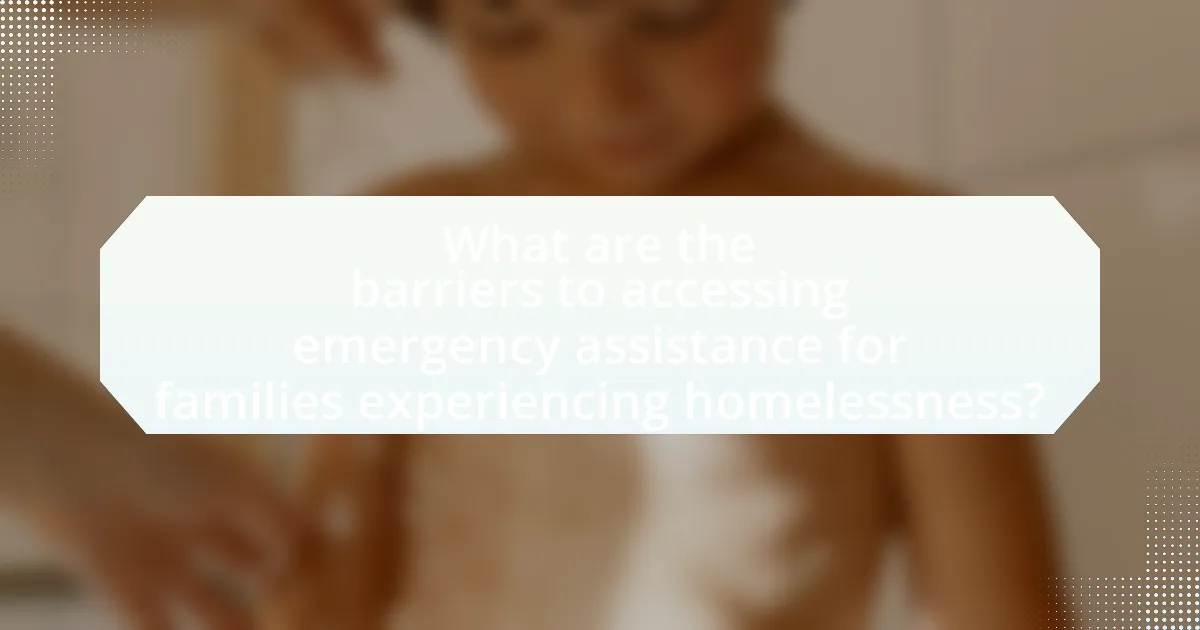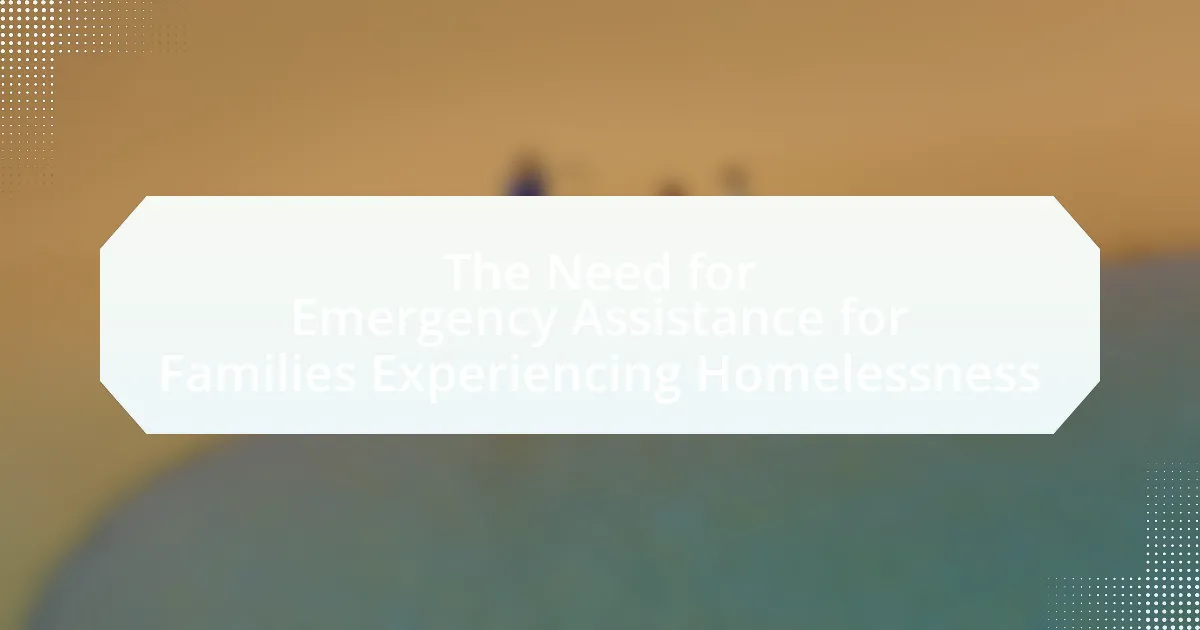Emergency assistance for families experiencing homelessness is essential for providing immediate shelter, food, and support services to those in crisis. Families facing homelessness often encounter severe challenges, including health issues, educational disruptions for children, and increased vulnerability to violence. The article outlines the urgent need for targeted assistance, the immediate needs of these families, and the common causes of their homelessness, such as economic instability and domestic violence. It also discusses the types of emergency assistance available, the role of local governments, and the barriers families face in accessing these resources. Furthermore, the article emphasizes the importance of long-term solutions, community resources, and advocacy efforts to improve emergency assistance services for families in need.

What is the Need for Emergency Assistance for Families Experiencing Homelessness?
Emergency assistance for families experiencing homelessness is crucial to provide immediate shelter, food, and support services. Families facing homelessness often lack the resources to secure stable housing, which can lead to severe consequences such as health issues, educational disruptions for children, and increased vulnerability to violence. According to the U.S. Department of Housing and Urban Development, families with children represent a significant portion of the homeless population, highlighting the urgent need for targeted assistance. Emergency programs can help stabilize these families, preventing long-term homelessness and promoting their reintegration into society.
Why is emergency assistance crucial for families facing homelessness?
Emergency assistance is crucial for families facing homelessness because it provides immediate support to prevent further deterioration of their living situation. This assistance often includes access to shelter, food, and essential services, which are vital for maintaining health and stability. According to the National Alliance to End Homelessness, families with children are among the fastest-growing segments of the homeless population, highlighting the urgent need for timely intervention. Emergency assistance can help families secure temporary housing, which is essential for children’s well-being and educational continuity, thereby reducing the long-term impacts of homelessness.
What are the immediate needs of families experiencing homelessness?
Families experiencing homelessness have immediate needs that include safe shelter, food, healthcare, and access to social services. Safe shelter is crucial as it provides a secure environment for families, particularly for children, to rest and feel safe. Food security is essential for maintaining health and well-being, as families often face hunger and malnutrition. Access to healthcare services is vital for addressing both physical and mental health issues that may arise from the stress of homelessness. Additionally, social services can assist families in finding stable housing, employment opportunities, and financial support, which are critical for long-term stability. According to the U.S. Department of Housing and Urban Development, families with children make up a significant portion of the homeless population, highlighting the urgency of addressing these immediate needs.
How does homelessness impact family dynamics and well-being?
Homelessness significantly disrupts family dynamics and negatively affects overall well-being. Families experiencing homelessness often face increased stress, which can lead to conflict and breakdowns in communication among family members. Research indicates that children in homeless families are at a higher risk for emotional and behavioral issues, with studies showing that 25% of homeless children exhibit significant mental health problems compared to their housed peers. Additionally, the instability associated with homelessness can hinder parental ability to provide consistent support and nurturing, further exacerbating feelings of insecurity and anxiety within the family unit. This cycle of stress and instability can lead to long-term adverse effects on both individual family members and the family as a whole.
What are the common causes of homelessness among families?
The common causes of homelessness among families include economic instability, lack of affordable housing, domestic violence, and health issues. Economic instability often results from job loss or low wages, making it difficult for families to maintain stable housing. The shortage of affordable housing exacerbates this issue, as rising rents outpace income growth. Domestic violence forces many families to flee their homes, leading to homelessness. Additionally, health issues, including mental illness and substance abuse, can disrupt family stability and contribute to housing loss. According to the U.S. Department of Housing and Urban Development, families with children represent a significant portion of the homeless population, highlighting the urgent need for targeted assistance.
How do economic factors contribute to family homelessness?
Economic factors significantly contribute to family homelessness by creating barriers to affordable housing and stable income. Families facing unemployment or underemployment often struggle to meet basic needs, leading to housing instability. For instance, a report from the National Low Income Housing Coalition indicates that in 2021, a family needed to earn at least $24.90 per hour to afford a modest two-bedroom rental home, while the federal minimum wage remains at $7.25 per hour. This disparity highlights how insufficient income directly correlates with the risk of homelessness. Additionally, rising housing costs and stagnant wages exacerbate the situation, forcing families to choose between housing and other essential expenses, ultimately increasing their vulnerability to homelessness.
What role does domestic violence play in family homelessness?
Domestic violence is a significant contributor to family homelessness, as it forces many families to flee their homes to escape abusive situations. According to the National Coalition for the Homeless, approximately 30% of homeless women report that domestic violence was the immediate cause of their homelessness. This violence not only disrupts family stability but also leads to a cycle of poverty and instability, making it difficult for affected families to secure safe and permanent housing. The intersection of domestic violence and homelessness highlights the urgent need for targeted emergency assistance and support services for families in crisis.
What types of emergency assistance are available for families experiencing homelessness?
Emergency assistance for families experiencing homelessness includes emergency shelters, transitional housing programs, rental assistance, and food assistance. Emergency shelters provide immediate housing and support services, while transitional housing programs offer longer-term solutions with supportive services to help families regain stability. Rental assistance programs, such as the Emergency Solutions Grant, help families cover rent costs to prevent eviction or homelessness. Food assistance programs, including the Supplemental Nutrition Assistance Program (SNAP), ensure families have access to nutritious meals during crises. These forms of assistance are crucial in addressing the immediate needs of families facing homelessness and facilitating their path to stability.
What services do shelters provide to homeless families?
Shelters provide essential services to homeless families, including temporary housing, food assistance, and access to healthcare. These services are designed to meet immediate needs and facilitate the transition to stable living conditions. For instance, many shelters offer case management to help families secure permanent housing and connect them with social services, such as job training and childcare. According to the National Alliance to End Homelessness, shelters play a critical role in providing a safe environment and resources that support families in overcoming homelessness.
How do financial assistance programs support families in crisis?
Financial assistance programs support families in crisis by providing immediate monetary aid to cover essential needs such as housing, food, and healthcare. These programs, often funded by government and nonprofit organizations, aim to alleviate the financial burden that families face during emergencies, such as job loss or medical emergencies. For instance, the U.S. Department of Housing and Urban Development reported that emergency rental assistance programs helped prevent homelessness for over 1.5 million households during the COVID-19 pandemic, demonstrating their critical role in stabilizing families in distress.
How can communities effectively address the need for emergency assistance?
Communities can effectively address the need for emergency assistance by establishing coordinated response systems that include local government, non-profit organizations, and community volunteers. These systems should focus on immediate resource allocation, such as shelter, food, and medical care, to families experiencing homelessness. For instance, the U.S. Department of Housing and Urban Development reported that communities with integrated service models, like coordinated entry systems, can reduce the time families spend in emergency shelters by 30%. Additionally, training volunteers and staff in trauma-informed care can enhance the effectiveness of assistance provided, ensuring that families receive not only immediate help but also supportive services that address underlying issues.
What partnerships are essential for providing comprehensive support?
Essential partnerships for providing comprehensive support to families experiencing homelessness include collaborations between government agencies, non-profit organizations, and community service providers. Government agencies can offer funding and policy support, while non-profit organizations provide direct services such as shelter, food, and counseling. Community service providers, including healthcare and educational institutions, contribute resources and expertise to address the multifaceted needs of these families. Research indicates that integrated service delivery models, which leverage these partnerships, significantly improve outcomes for families in crisis, as evidenced by studies showing reduced homelessness duration and increased access to essential services.

What are the barriers to accessing emergency assistance for families experiencing homelessness?
Barriers to accessing emergency assistance for families experiencing homelessness include lack of awareness, bureaucratic hurdles, and eligibility restrictions. Many families are unaware of available resources or how to navigate the application process, which can be complicated and time-consuming. Additionally, some assistance programs have strict eligibility criteria that may exclude families based on income, family composition, or previous assistance received. According to the National Alliance to End Homelessness, these barriers contribute to the difficulty families face in securing timely and effective support, ultimately prolonging their experience of homelessness.
How do systemic issues affect families seeking help?
Systemic issues significantly hinder families seeking help by creating barriers to access essential services. These barriers include inadequate funding for social services, which leads to long wait times and limited availability of resources, making it difficult for families to receive timely assistance. For instance, a report from the National Alliance to End Homelessness indicates that over 600,000 individuals experience homelessness on any given night in the United States, highlighting the overwhelming demand for services that often outstrip supply. Additionally, systemic discrimination based on race, socioeconomic status, and family structure can further marginalize families, preventing them from obtaining necessary support. This systemic inequity exacerbates their vulnerability, making it challenging for them to escape cycles of poverty and homelessness.
What challenges do families face when navigating assistance programs?
Families face several challenges when navigating assistance programs, including complex eligibility requirements, limited availability of resources, and bureaucratic hurdles. These challenges often lead to confusion and frustration, making it difficult for families to access the support they need. For instance, a study by the Urban Institute found that 60% of families reported difficulty understanding the application process for assistance programs, which can result in delays or denials of aid. Additionally, many programs have stringent income thresholds that can disqualify families who are just above the poverty line, further complicating their access to necessary resources.
How does stigma impact families experiencing homelessness?
Stigma significantly impacts families experiencing homelessness by exacerbating their social isolation and hindering access to resources. Families facing homelessness often encounter negative stereotypes that portray them as irresponsible or undeserving, which can lead to discrimination from the community and service providers. This stigma can result in reduced opportunities for employment, housing, and social support, as individuals may be reluctant to engage with those they perceive as homeless. Research indicates that stigma can lead to mental health issues, such as anxiety and depression, further complicating their situation. A study published in the American Journal of Public Health found that stigma associated with homelessness can deter families from seeking necessary assistance, ultimately prolonging their experience of homelessness.
What role do local governments play in providing emergency assistance?
Local governments play a crucial role in providing emergency assistance to families experiencing homelessness by coordinating resources, implementing policies, and delivering services directly to affected individuals. They often establish emergency shelters, provide financial aid for housing, and connect families with social services, ensuring immediate support during crises. For instance, according to the U.S. Department of Housing and Urban Development, local governments are responsible for administering federal funds, such as the Emergency Solutions Grant program, which allocates resources specifically for homelessness prevention and rapid rehousing initiatives. This direct involvement enables local governments to respond effectively to the unique needs of their communities, thereby mitigating the impact of homelessness.
How can policy changes improve access to emergency assistance?
Policy changes can improve access to emergency assistance by streamlining application processes and increasing funding for programs. Simplified procedures reduce barriers for families experiencing homelessness, allowing quicker access to necessary resources. For instance, the implementation of online application systems has been shown to increase participation rates by 30%, as evidenced by a study from the Urban Institute. Additionally, increasing funding for emergency assistance programs enables more families to receive timely support, which is critical in preventing long-term homelessness.
What funding sources are available for emergency assistance programs?
Emergency assistance programs can be funded through various sources, including federal grants, state and local government funding, private donations, and nonprofit organizations. Federal grants, such as those from the U.S. Department of Housing and Urban Development (HUD), provide significant financial support for emergency assistance initiatives. Additionally, state and local governments often allocate budgetary resources to address homelessness and emergency needs within their communities. Private donations from individuals and businesses, as well as funding from nonprofit organizations, also play a crucial role in sustaining these programs. For example, the Emergency Solutions Grant (ESG) program is a federal initiative that directly supports emergency assistance efforts, demonstrating the importance of government funding in this sector.

What are the long-term solutions to prevent family homelessness?
Long-term solutions to prevent family homelessness include increasing affordable housing availability, implementing supportive housing programs, and enhancing access to mental health and substance abuse services. Increasing affordable housing availability addresses the root cause of homelessness by ensuring families can secure stable living conditions. Supportive housing programs, which combine housing assistance with social services, have been shown to reduce homelessness rates significantly; for instance, a study by the National Alliance to End Homelessness found that supportive housing reduces homelessness by 80% for families. Additionally, enhancing access to mental health and substance abuse services helps families manage challenges that may lead to housing instability, as evidenced by research from the Substance Abuse and Mental Health Services Administration, which indicates that integrated services improve housing retention rates.
How can education and job training programs help families?
Education and job training programs can help families by providing them with the skills and knowledge necessary to secure stable employment, which is crucial for financial stability. These programs often lead to higher earning potential; for instance, individuals who complete vocational training can earn up to 20% more than those without such qualifications. Additionally, access to education and training can reduce the likelihood of homelessness by equipping families with the tools to improve their economic situation, as evidenced by studies showing that job training programs significantly decrease the risk of returning to homelessness.
What community resources are effective in preventing homelessness?
Community resources effective in preventing homelessness include emergency financial assistance programs, housing counseling services, and supportive housing initiatives. Emergency financial assistance programs provide immediate funds to cover rent or utility payments, helping families avoid eviction. Housing counseling services offer guidance on budgeting, credit repair, and navigating housing options, which can empower families to maintain stable housing. Supportive housing initiatives combine affordable housing with wraparound services, such as mental health support and job training, which have been shown to reduce homelessness rates significantly. For instance, a study by the National Alliance to End Homelessness found that supportive housing reduces homelessness by 70% among participants.
How can affordable housing initiatives support families at risk?
Affordable housing initiatives can support families at risk by providing stable and secure living conditions that reduce the likelihood of homelessness. These initiatives often include subsidies, low-interest loans, and the development of affordable housing units, which directly address the financial barriers that families face. For instance, a study by the National Low Income Housing Coalition found that families who receive housing assistance are 50% less likely to experience homelessness compared to those who do not. By ensuring access to affordable housing, these initiatives help families maintain their housing stability, improve their overall well-being, and foster a supportive community environment.
What best practices can be implemented to enhance emergency assistance programs?
To enhance emergency assistance programs for families experiencing homelessness, implementing a comprehensive needs assessment process is essential. This process involves evaluating the specific needs of families to tailor assistance effectively, ensuring that resources are allocated where they are most needed. Research indicates that programs utilizing needs assessments can improve service delivery and outcomes; for instance, a study by the Urban Institute found that targeted interventions based on assessed needs led to a 30% increase in successful housing placements. Additionally, fostering partnerships with local organizations can enhance resource availability and support networks, as collaboration often leads to more holistic assistance.
How can families advocate for better emergency assistance services?
Families can advocate for better emergency assistance services by actively engaging with local government representatives and participating in community meetings to voice their needs. By sharing personal experiences and data on the challenges faced during emergencies, families can highlight gaps in current services. Research indicates that advocacy efforts, such as organized campaigns and collaboration with local nonprofits, can lead to policy changes that improve emergency assistance programs. For instance, a study by the National Alliance to End Homelessness found that community-driven advocacy significantly influenced funding allocations for emergency services, demonstrating the effectiveness of family involvement in these initiatives.

Leave a Reply